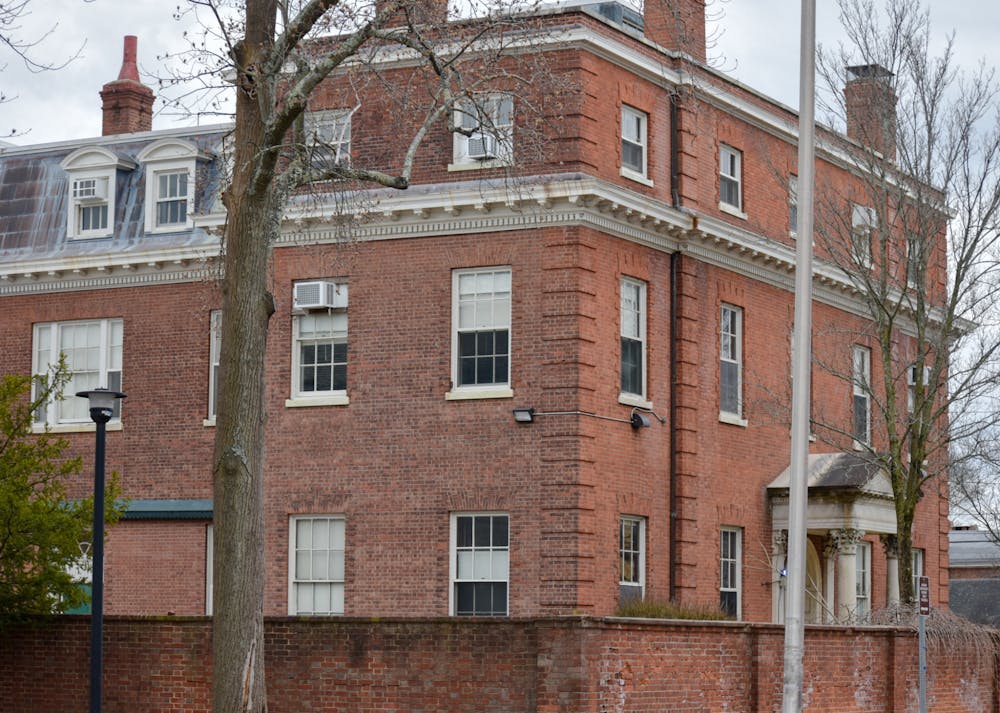Most University students on campus today have experienced two iterations of Andrews House: as a COVID-19 testing center and, for this academic year, the temporary home of the Department of Africana Studies and the Rites and Reason Theatre.
The structure located at 13 Brown St., though, has been much more than a testing site and makeshift academic building. Before 2021, it served as the hub of campus health services for the better part of 82 years, and before then, as a faculty club and the Rhode Island Governor’s Mansion.
Foundation and early history
Built in 1901 for Rhode Island textile manufacturer James Coats, 13 Brown St. is a 29-room mansion that was designed by New York architect Ogden Codman, according to Encyclopedia Brunoniana. The 2003 Guide to Providence Architecture called the mansion “the crispest neo-Georgian house that Providence had thus far seen” at the time of its construction.
In 1915, it became the Rhode Island Governor’s Mansion, housing former Governor R. Livingston Beekman until 1921.
In 1922, the University purchased the property and opened its first Faculty Club, which served to improve “intellectual understanding and cooperation” amongst faculty members, former University President William Faunce said at the time. Single faculty members, teaching assistants and graduate students could also pay rent to live on the building’s upper floors, according to Encyclopedia Brunoniana.
Transition to student health care facility
In January 1939, 13 Brown St. officially became Andrews House — a 50-bed student health care facility — while the Faculty Club moved to 1 Bannister St. Named after Elisha Benjamin Andrews, the president of the University from 1889 to 1898, renovations were made possible by $390,000 worth of donations.
During the building’s opening, then-University President Henry Wriston described it as “one of the finest and most completely equipped college infirmaries in the country,” The Herald previously reported.
When opened, the health care center featured a modern dental examination room, an X-ray machine, adjustable hospital beds, a library, a kitchen and spacious, well-lit rooms. These features were chosen after a “year’s study of the University’s infirmary needs,” the same Herald article reported.
Andrews House treated students afflicted with a wide variety of illnesses, including dining hall-inflicted food poisoning, the H2N2 virus pandemic of the late 1950s and countless other health concerns. As the years went on, Andrews House remained an important resource for students. According to a 1974 article in The Herald, the average student visited Andrews House between eight and 12 times a year.
Student grievances
In December 1946, a Pembroke College student denounced an Andrews House policy in a Herald letter to the editor. The rule, which she wrote had no “intelligent basis,” required women to be married to a patient in order to visit men staying in the building.
The writer argued that the policy was unfair to women due to a double standard permitting male visitors with no prerequisites. The woman accused nurses at Andrews House of being “uncooperative,” “plain rude” and of treating women as if they were “interloper(s) trespassing in a forbidden land.”
In 1949, The Herald published a series of editorials concerning the health facilities at the University, which intended to “decry” the “decidedly unpleasant atmosphere which prospective patients are forced to cope with.” The first editorial accused Andrews House of being “enveloped in an icy mist of stylized bureaucracy."
The Herald later outlined the internal operations of Andrews House in the third and last editorial of the series, which informed the student body about what went on in the building behind the scenes. The article praised the cooperative relationship between Andrews House and nearby hospitals, as well as the separation policy between health and discipline that protected students from reprimand if their injury was related to University misconduct.
Phasing out Andrews House
In September 1981, The Herald reported on a tentative plan to reorganize Health Services, including by decentralizing operations and renovating Andrews House. The University began a new system “attempting to shift health services’ efforts from health care to preventative treatment and health education.”
The decentralization of Health Services operations away from Andrews House continued over the next few decades. In 2018, those efforts coalesced in a new proposal to once again centralize the University's Health Services operations in a joint residence hall and wellness center at 450 Brook St., which would absorb both Health Services and Counseling and Psychological Services. The Brown University Health and Wellness Center was completed in May 2021, permanently removing Andrews House from the center of student health.
Temporary uses
With the University no longer mandating student testing for COVID-19, the Andrews House site closed in November 2021. For the 2022-23 year, Andrews House was transformed to house the Department of Africana Studies and the Rites and Reason Theatre while the department’s previous location at Churchill House undergoes renovations, The Herald previously reported.
According to Elmo Terry-Morgan ’74, associate professor of Africana Studies and Theater Arts and Performance Studies, evidence of the building’s past health care purposes remains present today.
“What we now use as the archiving room was the old infirmary,” he wrote in an email to The Herald. “Also, there are sinks in many of the offices, since they used to be examination rooms.”
Terry-Morgan, Rites and Reason’s artistic director, acknowledged that the “tiny offices” and “limited parking” have posed some challenges for his department, but his favorite part of the building’s unique layout is the first-floor ballroom, which he frequently uses as a space for class meetings and rehearsals. “Overall, Andrews House is a lovely, gracious building,” he added.
Kathy Moyer, stage and production manager for the Rites and Reason Theatre, also expressed her admiration for the building’s design in an email to The Herald. “The architectural details are just beautiful.”
"While we’re here," Moyer wrote, all students "are welcome."





